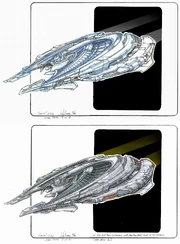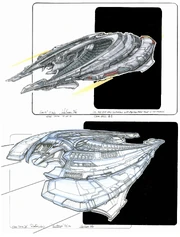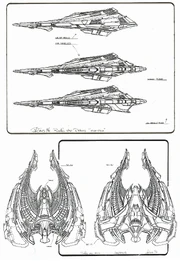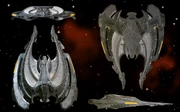m (lnk.fx.) |
m (→Design: typo) |
||
| Line 6: | Line 6: | ||
==Design== |
==Design== |
||
| − | Eaves is a designer who often gets his inspiration from everyday objects that catches his eye, as was the case with his designs for the Son'a ships, "''All the Son'a ships are from activity games I found out in the backyard. I wanted to give a whole different kind of look to their architecture, so I kind of went with yard toys - Ru'afo's ship is based on a {{w|horseshoe}}, the battleship is based on a boomerang, the shuttle is a yard dart, and the science vessel ... well, the front of it is sort of a badminton shuttlecock turned inside out.''" Eaves elaborated on his initial ideas by adding details he got elsewhere, "''[The ships] also have a kind of an inset detail that looks like a bunch of riblets; I based that on the strings inside a piano. I thought it would be fun to do that - their design is kind of like intricate wiring and framework, which is inset but open so you can see it. That was what I used as their kind of icon of design. It's on all the ships to an extent; you can see it extensively on Ru'afo's ship and the battleship, while the other had it inserted.''" ({{STTM|1|3}}, p. 21) The {{w|Grand Piano}} concept for the internals were inspired during Eaves' visit to the sound stage while [[Jerry Goldsmith]] scored {{film|8}}, "''I remember, the first thing I started doing as I went over to see Jerry Goldsmith score on ''First Contact'', and the big grand piano was open, and |
+ | Eaves is a designer who often gets his inspiration from everyday objects that catches his eye, as was the case with his designs for the Son'a ships, "''All the Son'a ships are from activity games I found out in the backyard. I wanted to give a whole different kind of look to their architecture, so I kind of went with yard toys - Ru'afo's ship is based on a {{w|horseshoe}}, the battleship is based on a boomerang, the shuttle is a yard dart, and the science vessel ... well, the front of it is sort of a badminton shuttlecock turned inside out.''" Eaves elaborated on his initial ideas by adding details he got elsewhere, "''[The ships] also have a kind of an inset detail that looks like a bunch of riblets; I based that on the strings inside a piano. I thought it would be fun to do that - their design is kind of like intricate wiring and framework, which is inset but open so you can see it. That was what I used as their kind of icon of design. It's on all the ships to an extent; you can see it extensively on Ru'afo's ship and the battleship, while the other had it inserted.''" ({{STTM|1|3}}, p. 21) The {{w|Grand Piano}} concept for the internals were inspired during Eaves' visit to the sound stage while [[Jerry Goldsmith]] scored {{film|8}}, "''I remember, the first thing I started doing as I went over to see Jerry Goldsmith score on ''First Contact'', and the big grand piano was open, and I remember seeing all those strings. And I thought 'Wouldn't be that a great idea for a ship'. And when ''Insurrection'' came along, I thought, I transfer all those ideas over. And so everything you'll see in the Son'a world has kind of an open piano look. You see a lot of repetitive strings, a lot of repetitive kind of wiring going through the main architecture. And the thing with Ru'afo's ship, you'll see that through the interior of the ship.''" ({{DVD|Star Trek: Insurrection|Special Edition| (Special Edition DVD)}}, special feature "The Art of Insurrection") He added, "''I tried to combine the horseshoe shape with the inside of a piano. You see all the wires, which I thought was kind of cool.''" (''[[The Secrets of Star Trek: Insurrection]]'', p. 88) |
[[File:Ru'afo's flagship original orientation design by John Eaves.jpg|thumb|Eaves original orientation design intent for Ru'afo's ship in February 1998]] |
[[File:Ru'afo's flagship original orientation design by John Eaves.jpg|thumb|Eaves original orientation design intent for Ru'afo's ship in February 1998]] |
||
Revision as of 12:30, 8 October 2012
Template:Realworld

Ru'afo's flagship
The script of Star Trek: Insurrection did not give any description of Ru'afo's flagship, leaving Illustrator John Eaves up to his own devices to come up with a design for the ship, which suited him just fine, "The script usually just says: 'A giant battleship sweeps across the screen.' The writers know from their point of view that they need a ship, but they usually don't want to influence in any way what the design's going to look like. They know that's kind of our specialty in the art department, so they rely on us to come up with the shapes. If it's something they really like, they can change a script point to fit in with the ship or vice versa. When I get the list I start roughing out shapes, and then I'll turn them over [to the producers]. They usually wait to have something to look at before they say anything - they're more visual than verbal at that end, so they really like to have something in front of them to go by. They'll always refer to the sketches to make decisions on other ideas. Once they get sketches they can break it down and say, 'We like this, we don't like that.' They're not always sure; at points they'll say, 'We don't know what we don't like about it,' and we'll keep going from there. It's a fun way to work, especially as there is so much free reign."
Nevertheless, Eaves was aware that he had to confirm to a certain set of unwritten rules that applied to the Star Trek universe, where it came to designing alien ships, "Even though you want to be as different as you can, there are a lot of parameters that they need you to stick by. The more alien, the more absurd, you go, the more they shoot it down. Even though you're dealing with an alien race, they're still humanoid in form, so their design senses kind of follow that too. If you get too extreme, those designs are usually shunned; they still get drawn, they just get dumped! You need the same set of pieces that make up a ship. You need a bridge, and the body of the craft - even though it's as alien as can be - still needs that kind of rigid Star Trek look. It's almost a challenge in a way to be different and yet stick with something familiar." (Star Trek: The Magazine Volume 1, Issue 3, p. 20)
Design
Eaves is a designer who often gets his inspiration from everyday objects that catches his eye, as was the case with his designs for the Son'a ships, "All the Son'a ships are from activity games I found out in the backyard. I wanted to give a whole different kind of look to their architecture, so I kind of went with yard toys - Ru'afo's ship is based on a horseshoe, the battleship is based on a boomerang, the shuttle is a yard dart, and the science vessel ... well, the front of it is sort of a badminton shuttlecock turned inside out." Eaves elaborated on his initial ideas by adding details he got elsewhere, "[The ships] also have a kind of an inset detail that looks like a bunch of riblets; I based that on the strings inside a piano. I thought it would be fun to do that - their design is kind of like intricate wiring and framework, which is inset but open so you can see it. That was what I used as their kind of icon of design. It's on all the ships to an extent; you can see it extensively on Ru'afo's ship and the battleship, while the other had it inserted." (Star Trek: The Magazine Volume 1, Issue 3, p. 21) The Grand Piano concept for the internals were inspired during Eaves' visit to the sound stage while Jerry Goldsmith scored Star Trek: First Contact, "I remember, the first thing I started doing as I went over to see Jerry Goldsmith score on First Contact, and the big grand piano was open, and I remember seeing all those strings. And I thought 'Wouldn't be that a great idea for a ship'. And when Insurrection came along, I thought, I transfer all those ideas over. And so everything you'll see in the Son'a world has kind of an open piano look. You see a lot of repetitive strings, a lot of repetitive kind of wiring going through the main architecture. And the thing with Ru'afo's ship, you'll see that through the interior of the ship." (Star Trek: Insurrection (Special Edition DVD), special feature "The Art of Insurrection") He added, "I tried to combine the horseshoe shape with the inside of a piano. You see all the wires, which I thought was kind of cool." (The Secrets of Star Trek: Insurrection, p. 88)

Eaves original orientation design intent for Ru'afo's ship in February 1998
As the first Son'a ship to make an appearance in the movie, Ru'afo's ship was the first one Eaves addressed. Eaves continued, "And this was also the movie were we decided that scales were going to be the very most important aspect to the drawings. The scales of the ships in Insurrection changed drastically throughout the effects part of the film, based on what would be seen with the story, and how the scenes would play out. And from that point we all kind of decided we needed a scale set, so we started making drawings that would show those scales, and you would have everything in comparison with the Enterprise-E. And from there Ru'afo's ship was slightly smaller, maybe about the same size as the dish of the Enterprise." (Star Trek: Insurrection (Special Edition DVD), special feature "The Art of Insurrection") In February 1998, Eaves finished up on his design of Ru'afo's ship and started the preliminary design work on the Son'a battle cruiser, "The Son'a ship designs are kind of based on a horseshoe, and I drew it to fly with the forks forward, because it looked more aggressive." (The Secrets of Star Trek: Insurrection, p. 87) However, when turned over for appraisal, Eaves soon found out that his designs were misinterpreted, "We had a lot of trouble with Ru'afo's ship. I had drawn it where the more aggressive angle was the open fork at the front; that was the way it was meant to go. When I turned it over to the meeting, they had the impression that it was flying the other way. I guess I made the assumption that I always draw things flying forward and I forgot to indicate that on the drawing." (Star Trek: The Magazine Volume 1, Issue 3, p. 21)

Eaves reversed orientation design for Ru'afo's ship finalized in April 1998
As it turned out, it was Co-Producer Peter Lauritson who had different ideas, "There was also a funny thing, because Peter Lauritson was our effects supervisor, and when I sent the drawings over, he liked what he saw, he started getting it all approved. And then when we started to do the plan view, he goes, 'Okay, put the engines on this side, make them glow over here.', and I go, 'Oh, that's is the front of the ship'. And so we this huge kind of a discussion on which way the ship was going to fly at that point. And I had drawn everything with that kind of forward fork motion, kind of carried the architecture through it, and Peter liked the opposite view. And so I remember we went all over that drawing to make it go the right direction, carry the right way, and that was kind of funny. So after that, we started putting on arrows on everything too, when we go into the meetings to show which direction they would initially supposed to go." (Star Trek: Insurrection (Special Edition DVD), special feature "The Art of Insurrection") As for the meetings, Eaves further recalled, " They did all their meetings and plans with it flying the other way, so when I got into the detailed identification of the parts, they said, 'What's the bridge doing in the back?' They understood my point of view, but it was a pretty heavy discussion on which way it was going to fly, and I fought for it pointing the more aggressive way. If you don't know you couldn't tell, but I still feel that it's going backwards!" (Star Trek: The Magazine Volume 1, Issue 3, p. 21) The discussions to and fro took almost two months, and it was not until April that Eaves presented his final redrawn design sketches with the adjusted flight direction. Years later, Eaves conceded that, "(...)overall it didn’t really make a big difference. That is being that that was over 10 years ago, so my sadness has faded." [1]
CGI model

Eaves' elevation plans for SBS
The movie Insurrection, was the first feature film were it was conceived that all the visual effects would be executed as computer-generated imagery (CGI). At that point in time, the technique was till relatively new, and the workload entailed in creating these effects was such that it was decided to employ two effects houses for their creation; Blue Sky/VIFX, was contracted to provide all planet bound effects, as well as the interior Son'a collector visuals (and, as it turned out during production, its destruction as well), whereas Santa Barbara Studios (SBS) would be responsible for all the space bound visuals. The construction of Ru'afo's ship therefore fell to SBS. SBS' Effects Supervisor John Grower stated, "John sent us elevation views and one or two 3/4 perspective drawings of each ship, but we had to do a lot of deduction work. The Son'a Flagship and Battleships had very complex shapes and all of these incredible compound curves, which didn't appear in the plan views. They're thin in one dimension and very wide and long in the other, kind of like a trilobite. The biggest challenge was that the Son'a ships didn't look the same from one angle to the next, so if we rotated around them a little bit, their profile changed because they had hundreds of compound curves that hooked together to form their shape. Getting it all to flow involved a ton of work and a very long modeling process." Apart from the intricate designs, creating digital ships on the computer was a labor, and time consuming effort from a technological standpoint as well, given the state of CGI technology at the time, as Grower further recalled, "Each ship was made up of lots of nurb surfaces, and the databases were hundreds of megabytes per ship. These models were very heavy, but Maya [remark: the CGI software package of choice at SBS] allowed us to efficiently structure and organize the data. We went through several iterations [of the ship designs] before we got approval, and Maya helped a lot there as well. Once we got the ships approved, of course, we had to make them look real."

SBS' finalized CGI model of Ru'afo's ship
As for texturing the CGI models, instead applying texture maps, the skin, around their wireframe models, as is the later commonplace method, SBS used a method called "slide projectors" by Grower, "Imagine a spaceship with all of these slide projectors pointed at various parts of it, projecting high-resolution images which dissolve from one projector to the next where they overlap so we don't see any seams. That allows us to have infinite detail as we rotate around the ship, without all of the stretching problems that occur when we wrap a flat object around 3-D geometry. It was imperative for us to use this approach because of the multi-curved surfaces of the ships. Also, instead of having a texture for every nurb surface, which is what we did before — and there might be hundreds — this technique enabled us to simultaneously project onto several nurb surfaces. Instead of having a hundred textures, we had 30 or so, over which we'd add dozens of layers of different textures and 'effects maps' per ship to create highlights and other things, and then we'd render them with Renderman. It was very time-consuming to get the CG models to look right, because the filmmakers have been shooting [the Trek] models for a long time, and they knew exactly what type of look they wanted. They would make us revise the models until they were right, which was very difficult." (American Cinematographer, January 1999, pp. 41-42)
Still Animation Supervisor James Strauss considered the effort worthwhile, "There is a kind of look and feel in the way ships move and conduct themselves in these pictures, and it is usually like a naval battle, with broadsides being fired off. In this movie there was an attempt to do more wild actions–probably since we were using CG and didn't have to worry about the lack of flexibility with [physical] model mounts." (Cinefex, isuue 77, p. 79)
Though later mentioned in the Star Trek: Deep Space Nine television series, the Son'a would never again be featured, nor would any their ships, so the CGI models were not upgraded in the LightWave 3D CGI software.
